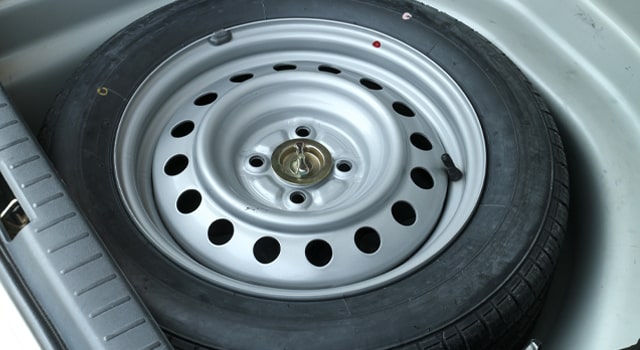If you’re wondering how long can you drive on a spare tire, chances are you’ve been driving on one for too long already. Here’s everything you need to know about spare tires and how long you can use them for.
Types of spare tires
There are two kinds of spares your car may have. A space-saving spare, better known as a donut, is smaller than your normal wheels. It’s designed to store away and get you out of a pinch. A full-size spare is the same kind of wheel as the set you drive on normally.
As an alternative, run-flat tires can give piece of mind when driving a car that doesn’t have a spare. These tires have additional reinforcement inside that allows them to be driven temporarily after a puncture.
Run-flats helps you avoid having to change a tire, and are stable when a puncture does happen. The downside of a run-flat is cost, as they’re typically more expensive than regular tires. If your run-flat is punctured, replace it as soon as possible.
How far can you drive on a spare tire?
A spare tire serves one purpose: to get you to safety where you can replace the flat. It’s not wise to drive on any spare tire longer than you have to.
Space-saver spares or donuts should be driven no more than 50 miles. If you’ve needed to use your spare, make an appointment at a tire shop or with a trusted mechanic as soon as possible.
These temporary spares are usually not the same size as the rest of your tires. They are often smaller, and have thinner contact patches. This can make your car handle unusually. Prolonged use of a donut can even cause stress and damage to your transmission or suspension.
How much time can you drive on a spare tire?
You should drive on a spare tire no longer than it takes you to get a new tire on.
Even if you’re driving with a full-sized spare, make it a priority to get to a tire shop or mechanic as soon as you can. Not only should you replace the blown tire, you should also have the mechanic ensure your wheel is tightened to factory specification.
When installing a spare tire, you’ll most likely use the included tire iron and tighten the spare by hand. The lug nuts holding your wheel to the car have a torque specification they need to be within. This prevents damage to the car, or in a worst-case scenario, your wheel coming loose while driving. Without the right tool, you won’t know if your lug nuts are too tight, too loose or unevenly tightened.
How long does a spare tire last in storage?
All tires, no matter if they’re a spare or not, are made of a rubber compound. Tires should be changed every six years or so, even if they’re not worn. The spare tire in your car will degrade even when it’s not in use.
Periodically inspect your spare tire for air pressure, and check the manufacturing date. On the sidewall of the tire, you’ll find a four digit number. This is the time code, and it tells you when the tire was manufactured.
The first two numbers indicate the week and the last two indicate the year the tire was made. For example, a tire with the number 0220 was manufactured on the second week of 2020. If your tire is getting old, replace it even if it’s a donut.
How fast can you drive on a spare tire?
In general, a donut spare should not be driven at speeds over 50 miles per hour. A donut has less grip than a normal tire. Take turns slowly and brake early and smoothly.
Driving on highways vs. roads
Since a donut spare isn’t meant for prolonged use or at speeds over 50 miles per hour, you should avoid driving on the highway with one. Instead, take local roads if possible. Travel in the lane furthest right and keep your speed under 50 mph.
Now that you’ve taken the time to take care of your spare, let us help take care of you. Drive assured with Plymouth Rock and you’ll have top-notch coverage with even better service.
Now let’s talk about you
Do you have the right coverage for your vehicle? We’d love to chat with you about it. Call us at 800-516-9242 or speak to a local agent.
If you’d rather not talk, you can get a quote quickly and easily online. Just enter your ZIP code to get started and see how much you could save!

